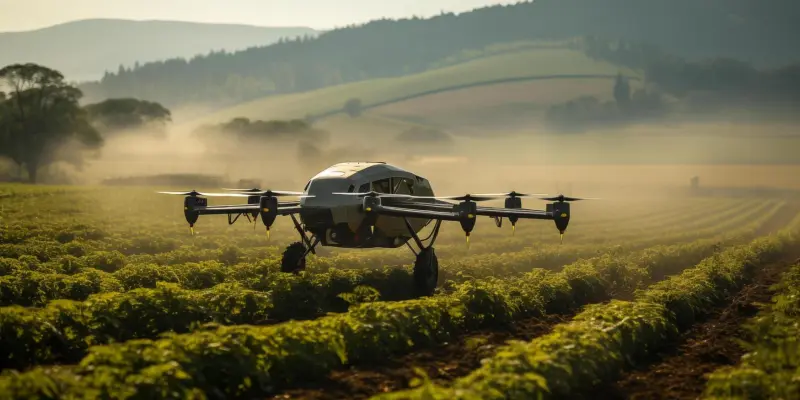In the ever-evolving landscape of technology, RoboBees stand out as a particularly intriguing development, crafted with the potential to transform various industries, particularly agriculture and environmental technology. These tiny robotic insects, developed by scientists at MIT and Harvard, aim to emulate the capabilities of real bees and offer a unique solution to pressing environmental problems. Utilizing intricate “pop-up microelectromechanical systems” reminiscent of origami techniques, RoboBees are designed to execute a range of tasks, including pollination, search and rescue operations, and military applications. The development of RoboBees serves as a testament to the merging of technology and the natural world, seeking to mitigate the impacts of challenges such as pollution and habitat loss that threaten bee populations globally.
Understanding RoboBees: Design and Capabilities
Tiny Marvels with Huge Potential
RoboBees, in their quest to mimic real bees, have been constructed to be remarkably small, weighing less than 100 milligrams and measuring approximately half the size of a natural bee. Their design incorporates the use of “pop-up microelectromechanical systems” that allow these robots to operate efficiently in a variety of settings, such as flying and hovering through the air and swimming in water. This versatility is crucial for tackling tasks that range from pollinating crops to assisting in search and rescue missions. The development of these tiny drones highlights the impact of innovative engineering and offers a glimpse into future possibilities for combining robotic technologies with real-world applications.
Challenges in Design and Implementation
Despite the remarkable potential, the complexity of RoboBees presents significant challenges that must be navigated carefully. Foremost among these are issues with battery life, as the energy demands for continuous flight and efficient sensor operation can quickly deplete a RoboBee’s power supply. Additionally, ensuring precise control over their movements remains a difficult task, especially when scaling operations for larger tasks or widespread environmental monitoring. The production costs are also a consideration, as affordability will play a significant role in determining the feasibility of deploying these robotic insects across various industries. Furthermore, environmental safety concerns are paramount since introducing robotic entities into ecosystems could potentially disrupt natural balances if not properly managed.
Applications and Their Impact Across Industries
Revolutionizing Agriculture with Robotic Pollinators
As the global bee population continues to decline due to environmental threats such as pollution and habitat loss, RoboBees offer a promising alternative for maintaining crop pollination. Farmers are continuously grappling with the challenge of ensuring adequate pollination, which is essential for crop yields and food security. RoboBees’ ability to autonomously navigate fields and pollinate flowers can play a crucial role in sustaining agricultural production levels. Furthermore, integrating these robots into agricultural practices may lead to increased resilience in food production systems by offering a degree of protection against climate change-induced uncertainties, providing a buffer for the future of the global food supply chain.
Expanding the Scope to Environmental Surveillance and Rescue
Beyond agriculture, RoboBees have immense potential to transform environmental monitoring and conservation efforts. Equipped with sensors, they can gather critical data on weather patterns, pollutant levels, and other environmental factors. This information could be invaluable in enhancing our understanding of climate change impacts and assisting scientists in developing more effective conservation strategies. Additionally, in disaster scenarios where human access is limited or dangerous, RoboBees can assist in search and rescue operations, searching for survivors and delivering vital supplies, thus playing a pivotal role in emergency response protocols. Their adaptability to various environments underscores their utility in diverse contexts, offering solutions across multiple domains.
The Road Ahead: Enhancements and Ethical Considerations
Possibilities for Technological Advancements
Looking forward, the future of RoboBees hinges on advancements in areas such as sensor technology and artificial intelligence (AI). Improving sensory capabilities and AI decision-making could significantly enhance their operational effectiveness, allowing RoboBees to perform complex tasks with greater autonomy. Researchers are continually working to overcome limitations related to energy efficiency, aiming to develop more sustainable power solutions. Collaborations across disciplines, including robotics, biology, and environmental science, are set to drive further innovations, potentially revolutionizing the ways we integrate technology into natural ecosystems and prompting more comprehensive dialogue on ethical considerations.
Balancing Innovation and Environmental Responsibility
Despite the promising future, ethical considerations surrounding the deployment of RoboBees must remain at the forefront. Balancing technological innovation with environmental conservation is critical to ensure that these robotic insects contribute positively without unintended ecological consequences. Careful study of their interaction with natural ecosystems is essential to identify potential risks and formulate guidelines for responsible usage. Stakeholders from various sectors, including environmental advocacy groups, policymakers, and scientists, must engage in discussions to assess the best practices for integrating RoboBees into society, ensuring their safe and effective application for the benefit of both technology and the natural world.
Navigating the Future of Robotics in Nature
RoboBees, designed to emulate natural bees, boast diminutive proportions, tipping the scales at under 100 milligrams, while measuring about half the size of their organic counterparts. Their sophisticated construction involves “pop-up microelectromechanical systems,” giving these robotic marvels the capability to operate effectively across diverse environments. They excel at performing feats like aerial acrobatics, fluttering through air, and even navigating aquatic landscapes. Such adaptability is essential for undertaking a myriad of tasks from crop pollination to contributing to search and rescue operations. The creation of these microdrones underscores the transformative power of cutting-edge engineering, paving the way for future synergy between robotics and practical applications. As these advancements continue to unfold, they promise a future where robotics increasingly intertwine with critical everyday functions, revolutionizing how we approach challenges in fields such as agriculture, disaster response, and beyond.

